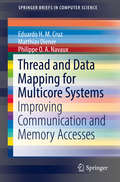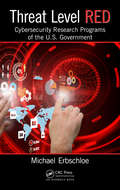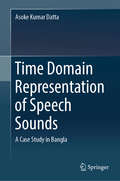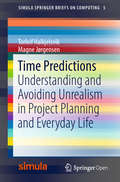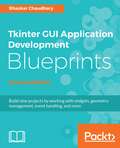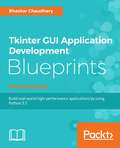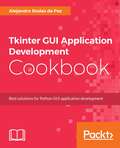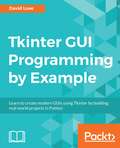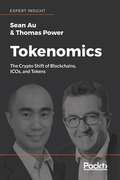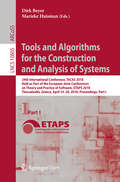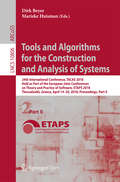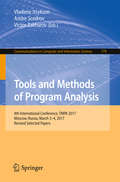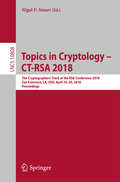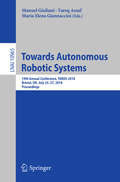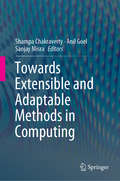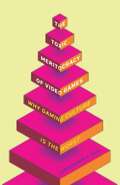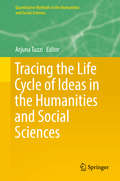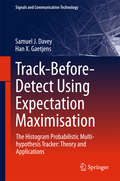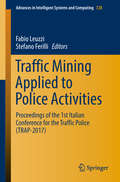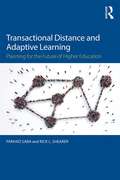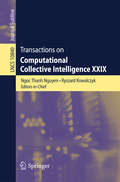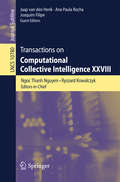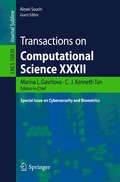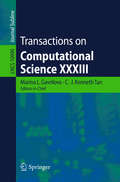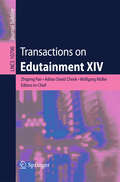- Table View
- List View
Thread and Data Mapping for Multicore Systems: Improving Communication and Memory Accesses (SpringerBriefs in Computer Science)
by Eduardo H. M. Cruz Matthias Diener Philippe O. A. NavauxThis book presents a study on how thread and data mapping techniques can be used to improve the performance of multi-core architectures.It describes how the memory hierarchy introduces non-uniform memory access, and how mapping can be used to reduce the memory access latency in current hardware architectures.On the software side, this book describes the characteristics present in parallel applications that are used by mapping techniques to improve memory access.Several state-of-the-art methods are analyzed, and the benefits and drawbacks of each one are identified.
Threat Level Red: Cybersecurity Research Programs of the U.S. Government
by Michael ErbschloeThere is extensive government research on cyber security science, technology, and applications. Much of this research will be transferred to the private sector to aid in product development and the improvement of protective measures against cyber warfare attacks. This research is not widely publicized. There are initiatives to coordinate these research efforts but there has never been a published comprehensive analysis of the content and direction of the numerous research programs. This book provides private sector developers, investors, and security planners with insight into the direction of the U.S. Government research efforts on cybersecurity.
Time Domain Representation of Speech Sounds: A Case Study In Bangla
by Asoke Kumar DattaThe book presents the history of time-domain representation and the extent of its development along with that of spectral domain representation in the cognitive and technology domains. It discusses all the cognitive experiments related to this development, along with details of technological developments related to both automatic speech recognition (ASR) and text to speech synthesis (TTS), and introduces a viable time-domain representation for both objective and subjective analysis, as an alternative to the well-known spectral representation.The book also includes a new cohort study on the use of lexical knowledge in ASR. India has numerous official dialects, and spoken-language technology development is a burgeoning area. In fact TTS and ASR taken together constitute the most important technology for empowering people. As such, the book describes time domain representation in such a way that it can be easily and seamlessly incorporated into ASR and TTS research and development. In short, it is a valuable guidebook for the development of ASR and TTS in all the Indian Standard Dialects using signal domain parameters.
Time Predictions: Understanding And Avoiding Unrealism In Project Planning And Everyday Life (Simula Springerbriefs On Computing Ser. #5)
by Magne Jørgensen Torleif HalkjelsvikThis book is published open access under a CC BY 4.0 license.Predicting the time needed to complete a project, task or daily activity can be difficult and people frequently underestimate how long an activity will take. This book sheds light on why and when this happens, what we should do to avoid it and how to give more realistic time predictions. It describes methods for predicting time usage in situations with high uncertainty, explains why two plus two is usually more than four in time prediction contexts, reports on research on time prediction biases, and summarizes the evidence in support of different time prediction methods and principles. Based on a comprehensive review of the research, it is the first book summarizing what we know about judgment-based time predictions. Large parts of the book are directed toward people wishing to achieve better time predictions in their professional life, such as project managers, graphic designers, architects, engineers, film producers, consultants, software developers, or anyone else in need of realistic time usage predictions. It is also of benefit to those with a general interest in judgment and decision-making or those who want to improve their ability to predict and plan ahead in daily life.
Tkinter GUI Application Development Blueprints, Second Edition: Build Nine Projects By Working With Widgets, Geometry Management, Event Handling, And More, 2nd Edition
by Bhaskar ChaudharyTkinter is the built-in GUI package that comes with standard Python distributions. It is a cross-platform package, which means you build once and deploy everywhere. It is simple to use and intuitive in nature, making it suitable for learners. This book will enable you to use Tkinter effectively through working on nine versatile projects.
Tkinter GUI Application Development Blueprints, Second Edition: Build nine projects by working with widgets, geometry management, event handling, and more, 2nd Edition
by Bhaskar Chaudhary Erik S. RapertGeometry Management, Event Handling, and moreKey FeaturesA Practical, guide to learn the application of Python and GUI programming with tkinterCreate multiple cross-platform real-world projects by integrating host of third party libraries and toolsLearn to build beautiful and highly interactive user interfaces, targeting multiple devices.Book DescriptionTkinter is the built-in GUI package that comes with standard Python distributions. It is a cross-platform package, which means you build once and deploy everywhere. It is simple to use and intuitive in nature, making it suitable for programmers and non-programmers alike.This book will help you master the art of GUI programming. It delivers the bigger picture of GUI programming by building real-world, productive, and fun applications such as a text editor, drum machine, game of chess, audio player, drawing application, piano tutor, chat application, screen saver, port scanner, and much more. In every project, you will build on the skills acquired in the previous project and gain more expertise. You will learn to write multithreaded programs, network programs, database-driven programs, asyncio based programming and more. You will also get to know the modern best practices involved in writing GUI apps. With its rich source of sample code, you can build upon the knowledge gained with this book and use it in your own projects in the discipline of your choice.What you will learn-A Practical, guide to help you learn the application of Python and GUI programming with Tkinter- Create multiple, cross-platform, real-world projects by integrating a host of third-party libraries and tools- Learn to build beautiful and highly interactive user interfaces, targeting multiple devices.Who this book is forThis book is for a beginner to intermediate-level Pythonists who want to build modern, cross-platform GUI applications with the amazingly powerful Tkinter. Prior knowledge of Tkinter is required.
Tkinter GUI Application Development Cookbook: A practical solution to your GUI development problems with Python and Tkinter
by Alejandro Rodas de PazDiscover solutions to all your Tkinter and Python GUI development problemsKey Features Integrate efficient Python GUI programming techniques with Tkinter Efficiently implement advanced MVC architectures in your Python GUI apps Solve all your problems related to Tkinter and Python GUI developmentBook DescriptionAs one of the more versatile programming languages, Python is well-known for its batteries-included philosophy, which includes a rich set of modules in its standard library; Tkinter is the library included for building desktop applications. Due to this, Tkinter is a common choice for rapid GUI development, and more complex applications can benefit from the full capabilities of this library. This book covers all of your Tkinter and Python GUI development problems and solutions.Tkinter GUI Application Development Cookbook starts with an overview of Tkinter classes and at the same time provides recipes for basic topics, such as layout patterns and event handling. Next, we cover how to develop common GUI patterns, such as entering and saving data, navigating through menus and dialogs, and performing long-running actions in the background.You can then make your apps leverage network resources effectively and perform graphical operations on a canvas and related tasks such as detecting collisions between items. Finally, this book covers using themed widgets, an extension of Tk widgets that have a more native look and feel. Finally, this book covers using the canvas and themed widgets.By the end of the book, you will have an in-depth knowledge of Tkinter classes, and will know how to use them to build efficient and rich GUI applications.What you will learnAdd widgets and handle user eventsLay out widgets within windows using frames and the different geometry managersConfigure widgets so that they have a customized appearance and behaviorImprove the navigation of your apps with menus and dialogsApply object-oriented programming techniques in Tkinter applicationsUse threads to achieve responsiveness and update the GUI Explore the capabilities of the canvas widget and the types of items that can be added to itExtend Tkinter applications with the TTK (themed Tkinter) moduleWho this book is forThis book is for Python developers who are familiar with the basics of the language syntax, data structures, and OOP. You do not need previous experience with Tkinter or other GUI development libraries.
Tkinter GUI Programming by Example: Learn to create modern GUIs using Tkinter by building real-world projects in Python
by David LoveLeverage the power of Python and its de facto GUI framework to build highly interactive interfacesKey Features The fundamentals of Python and GUI programming with Tkinter. Create multiple cross-platform projects by integrating a host of third-party libraries and tools. Build beautiful and highly-interactive user interfaces that target multiple devices.Book DescriptionTkinter is a modular, cross-platform application development toolkit for Python. When developing GUI-rich applications, the most important choices are which programming language(s) and which GUI framework to use. Python and Tkinter prove to be a great combination. This book will get you familiar with Tkinter by having you create fun and interactive projects. These projects have varying degrees of complexity. We'll start with a simple project, where you'll learn the fundamentals of GUI programming and the basics of working with a Tkinter application. After getting the basics right, we'll move on to creating a project of slightly increased complexity, such as a highly customizable Python editor. In the next project, we'll crank up the complexity level to create an instant messaging app. Toward the end, we'll discuss various ways of packaging our applications so that they can be shared and installed on other machines without the user having to learn how to install and run Python programs.What you will learn Create a scrollable frame via theCanvas widget Use the pack geometry manager andFrame widget to control layout Learn to choose a data structurefor a game Group Tkinter widgets, such asbuttons, canvases, and labels Create a highly customizablePython editor Design and lay out a chat windowWho this book is forThis book is for beginners to GUI programming who haven’t used Tkinter yet and are eager to start building great-looking and user-friendly GUIs. Prior knowledge of Python programming is expected.
Tokenomics: The Crypto Shift of Blockchains, ICOs, and Tokens
by Sean Au Thomas Power<p>Tokenomics is the economy of this new world. This is a no-holds-barred, in-depth exploration of the way in which we can participate in the blockchain economy. The reader will learn the basics of bitcoin, blockchains, and tokenomics; what the very first ICO was; and how over a period of 5 years, various projects managed to raise the enormous sums of money they did. The book then provides insights from ICO experts and looks at what the future holds. By comparing the past, current, and future of this technology, the book will inform anyone, whatever motivates their interest. <p>The crypto shift of blockchains, ICOs, and tokens is much more than just buying bitcoins, creating tokens, or raising millions in a minute in an ICO. It is a new paradigm shift from centralized to decentralized, from closed to open, and from opaqueness to transparency. ICOs and the creation of tokens during the craze of 2017 needed a lot of preparation, an understanding of cryptocurrencies and of emerging legal frameworks, but this has spurred a new movement to tokenize the world. <p>The author gives an unbiased, authoritative picture of the current playing field, exploring the token opportunities and provides a unique insight into the developing world of this tokenized economy. This book will nourish hungry minds wanting to grow their knowledge in this fascinating area.</p>
Tools and Algorithms for the Construction and Analysis of Systems: 24th International Conference, Tacas 2018, Held As Part Of The European Joint Conferences On Theory And Practice Of Software, Etaps 2018, Thessaloniki, Greece, April 14-20, 2018. Proceedings, Part I (Lecture Notes in Computer Science #10805)
by Dirk Beyer Marieke HuismanThis book is Open Access under a CC BY licence. The LNCS 10805 and 10806 proceedings set constitutes the proceedings of the 24th International Conference on Tools and Algorithms for the Construction and Analysis of Systems, TACAS 2018, which took place in Thessaloniki, Greece, in April 2018, held as part of the European Joint Conference on Theory and Practice of Software, ETAPS 2018. The total of 43 full and 11 short papers presented in these volumes was carefully reviewed and selected from 154submissions. The papers are organized in topical sections as follows: Part I: theorem proving; SAT and SMT I; deductive verification; software verification and optimization; model checking; and machine learning. Part II: concurrent and distributed systems; SAT and SMT II; security and reactive systems; static and dynamic program analysis; hybrid and stochastic systems; temporal logic and mu-calculus; 7th Competition on Software Verification – SV-COMP.
Tools and Algorithms for the Construction and Analysis of Systems: 24th International Conference, Tacas 2018, Held As Part Of The European Joint Conferences On Theory And Practice Of Software, Etaps 2018, Thessaloniki, Greece, April 14-20, 2018. Proceedings, Part I (Lecture Notes in Computer Science #10805)
by Dirk Beyer Marieke HuismanThis book is Open Access under a CC BY licence.The LNCS 10805 and 10806 proceedings set constitutes the proceedings of the 24th International Conference on Tools and Algorithms for the Construction and Analysis of Systems, TACAS 2018, which took place in Thessaloniki, Greece, in April 2018, held as part of the European Joint Conference on Theory and Practice of Software, ETAPS 2018.The total of 43 full and 11 short papers presented in these volumes was carefully reviewed and selected from 154submissions. The papers are organized in topical sections as follows:Part I: theorem proving; SAT and SMT I; deductive verification; software verification and optimization; model checking; and machine learning. Part II: concurrent and distributed systems; SAT and SMT II; security and reactive systems; static and dynamic program analysis; hybrid and stochastic systems; temporal logic and mu-calculus; 7th Competition on Software Verification – SV-COMP.
Tools and Methods of Program Analysis
by Vladimir Itsykson Andre Scedrov Victor ZakharovThis book constitutes the refereed proceedings of the 4th International Conference on Tools and Methods for Program Analysis, TMPA 2017, Moscow, Russia, March 3-4, 2017. The 12 revised full papers and 5 revised short papers presented together with three abstracts of keynote talks were carefully reviewed and selected from 51 submissions. The papers deal with topics such as software test automation, static program analysis, verification, dynamic methods of program analysis, testing and analysis of parallel and distributed systems, testing and analysis of high-load and high-availability systems, analysis and verification of hardware and software systems, methods of building quality software, tools for software analysis, testing and verification.
Topics in Cryptology – CT-RSA 2018: The Cryptographers' Track At The Rsa Conference 2018, San Francisco, Ca, Usa, April 16-20, 2018, Proceedings (Lecture Notes in Computer Science #10808)
by Nigel P. SmartThis book constitutes the refereed proceedings of the Cryptographer's Track at the RSA Conference 2018, CT-RSA 2018, held in San Francisco, CA, USA, in March 2018.The 26 papers presented in this volume were carefully reviewed and selected from 79 submissions. CT-RSA is the track devoted to scientific papers on cryptography, public-key to symmetric-key cryptography and from crypto- graphic protocols to primitives and their implementation security.
Towards Autonomous Robotic Systems: 19th Annual Conference, TAROS 2018, Bristol, UK July 25-27, 2018, Proceedings (Lecture Notes in Computer Science #10965)
by Manuel Giuliani Tareq Assaf Maria Elena GiannacciniThis book constitutes the refereed proceedings of the 19th Annual Conference on Towards Autonomous Robotics, TAROS 2018, held in Bristol, UK, in July 2018.The 38 full papers presented together with 14 short papers were carefully reviewed and selected from 68 submissions. The papers focus on presentation and discussion of the latest results and methods in autonomous robotics research and applications. The conference offers a friendly environment for robotics researchers and industry to take stock and plan future progress.
Towards Extensible and Adaptable Methods in Computing
by Shampa Chakraverty Anil Goel Sanjay MisraThis book addresses extensible and adaptable computing, a broad range of methods and techniques used to systematically tackle the future growth of systems and respond proactively and seamlessly to change. The book is divided into five main sections: Agile Software Development, Data Management, Web Intelligence, Machine Learning and Computing in Education. These sub-domains of computing work together in mutually complementary ways to build systems and applications that scale well, and which can successfully meet the demands of changing times and contexts. The topics under each track have been carefully selected to highlight certain qualitative aspects of applications and systems, such as scalability, flexibility, integration, efficiency and context awareness. The first section (Agile Software Development) includes six contributions that address related issues, including risk management, test case prioritization and tools, open source software reliability and predicting the change proneness of software. The second section (Data Management) includes discussions on myriad issues, such as extending database caches using solid-state devices, efficient data transmission, healthcare applications and data security. In turn, the third section (Machine Learning) gathers papers that investigate ML algorithms and present their specific applications such as portfolio optimization, disruption classification and outlier detection. The fourth section (Web Intelligence) covers emerging applications such as metaphor detection, language identification and sentiment analysis, and brings to the fore web security issues such as fraud detection and trust/reputation systems. In closing, the fifth section (Computing in Education) focuses on various aspects of computer-aided pedagogical methods.
The Toxic Meritocracy of Video Games: Why Gaming Culture Is the Worst
by Christopher A. PaulAn avid gamer and sharp media critic explains meritocracy’s negative contribution to video game culture—and what can be done about it Video games have brought entertainment, education, and innovation to millions, but gaming also has its dark sides. From the deep-bred misogyny epitomized by GamerGate to the endemic malice of abusive player communities, gamer culture has had serious real-world repercussions, ranging from death threats to sexist industry practices and racist condemnations. In The Toxic Meritocracy of Video Games, new media critic and longtime gamer Christopher A. Paul explains how video games’ focus on meritocracy empowers this negative culture. Paul first shows why meritocracy is integral to video-game design, narratives, and values. Games typically valorize skill and technique, and common video-game practices (such as leveling) build meritocratic thinking into the most basic premises. Video games are often assumed to have an even playing field, but they facilitate skill transfer from game to game, allowing certain players a built-in advantage.The Toxic Meritocracy of Video Games identifies deep-seated challenges in the culture of video games—but all is not lost. As Paul argues, similarly meritocratic institutions like professional sports and higher education have found powerful remedies to alleviate their own toxic cultures, including active recruiting and strategies that promote values such as contingency, luck, and serendipity. These can be brought to the gamer universe, Paul contends, ultimately fostering a more diverse, accepting, and self-reflective culture that is not only good for gamers but good for video games as well.
Tracing the Life Cycle of Ideas in the Humanities and Social Sciences: A Portrait Of A Discipline Through Analyses Of Scientific Literature (Quantitative Methods in the Humanities and Social Sciences)
by Arjuna TuzziThis book demonstrates how quantitative methods for text analysis can successfully combine with qualitative methods in the study of different disciplines of the Humanities and Social Sciences (HSS). The book focuses on learning about the evolution of ideas of HSS disciplines through a distant reading of the contents conveyed by scientific literature, in order to retrieve the most relevant topics being debated over time. Quantitative methods, statistical techniques and software packages are used to identify and study the main subject matters of a discipline from raw textual data, both in the past and today. The book also deals with the concept of quality of life of words and aims to foster a discussion about the life cycle of scientific ideas. Textual data retrieved from large corpora pose interesting challenges for any data analysis method and today represent a growing area of research in many fields. New problems emerge from the growing availability of large databases and new methods are needed to retrieve significant information from those large information sources. This book can be used to explain how quantitative methods can be part of the research instrumentation and the "toolbox" of scholars of Humanities and Social Sciences. The book contains numerous examples and a description of the main methods in use, with references to literature and available software. Most of the chapters of the book have been written in a non-technical language for HSS researchers without mathematical, computer or statistical backgrounds.
Track-Before-Detect Using Expectation Maximisation
by Samuel J. Davey Han X. GaetjensThis book offers a detailed description of the histogram probabilistic multi-hypothesis tracker (H-PMHT), providing an accessible and intuitive introduction to the mathematical mechanics of H-PMHT as well as a definitive reference source for the existing literature on the method. Beginning with basic concepts, the authors then move on to address extensions of the method to a broad class of tracking problems. The latter chapters present applications using recorded data from experimental radar, sonar and video sensor systems. The book is supplemented with software that both furthers readers’ understanding and acts as a toolkit for those who wish to apply the methods to their own problems.
Traffic Mining Applied to Police Activities: Proceedings Of The 1st Italian Conference For The Traffic Police (trap 2017) (Advances In Intelligent Systems And Computing #728)
by Fabio Leuzzi Stefano FerilliThis book presents high-quality original contributions on the development of automatic traffic analysis systems that are able to not only anticipate traffic scenarios, but also understand the behavior of road users (vehicles, bikes, trucks, etc.) in order to provide better traffic management, prevent accidents and, potentially, identify criminal behaviors. Topics also include traffic surveillance and vehicle accident analysis using formal concept analysis, convolutional and recurrent neural networks, unsupervised learning and process mining. The content is based on papers presented at the 1st Italian Conference for the Traffic Police (TRAP), which was held in Rome in October 2017. This conference represents a targeted response to the challenges facing the police in connection with managing massive traffic data, finding patterns from historical datasets, and analyzing complex traffic phenomena in order to anticipate potential criminal behaviors. The book will appeal to researchers, practitioners and decision makers interested in traffic monitoring and analysis, traffic modeling and simulation, mobility and social data mining, as well as members of the police.
Transactional Distance and Adaptive Learning: Planning for the Future of Higher Education
by Farhad Saba Rick L. ShearerTransactional Distance and Adaptive Learning takes a fresh look at one of the pioneering educational theories that accommodates the impact of information and communications technologies in learning. The theory of transactional distance (TTD) provides a distinct analytical and planning foundation for educators to conduct an overarching inquiry into transitioning from mass instructional and management systems in higher education to dynamic and transformational futures that focus on each individual learner. Based on the TTD, this pragmatic approach offers instructors, administrators, students, and other stakeholders a comprehensive planning method to assess the current state of their instructional, learning, and management practices and to develop alternative models to prescribe future improvements in their institution. This complex, self-organized, and adaptive method includes current and emergent properties of: hardware, software, and telecommunications systems that allow faculty, students, and administrators to communicate; instructional and curriculum systems that provide teaching and learning environments for faculty and students; and management, societal, and global systems that influence how institutions are supported, funded, and managed.
Transactions on Computational Collective Intelligence XXIX (Lecture Notes In Computer Science #10840)
by Ngoc Thanh Nguyen Ryszard KowalczykThese transactions publish research in computer-based methods of computational collective intelligence (CCI) and their applications in a wide range of fields such as the semantic Web, social networks, and multi-agent systems. TCCI strives to cover new methodological, theoretical and practical aspects of CCI understood as the form of intelligence that emerges from the collaboration and competition of many individuals (artificial and/or natural). The application of multiple computational intelligence technologies, such as fuzzy systems, evolutionary computation, neural systems, consensus theory, etc., aims to support human and other collective intelligence and to create new forms of CCI in natural and/or artificial systems. This twenty-ninth issue is a regular issue with 10 selected papers.
Transactions on Computational Collective Intelligence XXVIII
by Ngoc Thanh Nguyen Ryszard Kowalczyk Jaap van den Herik Ana Paula Rocha Joaquim FilipeThese transactions publish research in computer-based methods of computational collective intelligence (CCI) and their applications in a wide range of fields such as the semantic Web, social networks, and multi-agent systems. TCCI strives to cover new methodological, theoretical and practical aspects of CCI understood as the form of intelligence that emerges from the collaboration and competition of many individuals (artificial and/or natural). The application of multiple computational intelligence technologies, such as fuzzy systems, evolutionary computation, neural systems, consensus theory, etc., aims to support human and other collective intelligence and to create new forms of CCI in natural and/or artificial systems. This twenty-eight issue is a special issue with 11 selected papers from the International Conference on Agents and Artificial Intelligence, ICAART 2016 and 2017 editions.
Transactions on Computational Science XXXII: Special Issue On Cybersecurity And Biometrics (Lecture Notes in Computer Science #10830)
by Marina L. Gavrilova Alexei Sourin C.J. Kenneth TanThis, the 32nd issue of the Transactions on Computational Science, focusses on cybersecurity and biometrics. The eight detailed papers cover the following topics: Multimodal Warnings for Distracted Smartphone Users on the Move; EEG-Based Mental Workload and Stress Monitoring of Crew Members in a Maritime Virtual Simulator; Detecting Web Defacement and Enabling Web-Content Regeneration; Software as a Weapon in the Context of (Inter)national Security; Multi-user Architecture and Multi-player Games; An Adaptive Discrete Wavelet Transform Based Face Recognition Approach; Synthesizing Images of Imagined Faces Based on Relevance Feedback; and Neurofeedback Training to Enhance the Focused Attention of Elite Rifle Shooters.
Transactions on Computational Science XXXIII (Lecture Notes in Computer Science #10990)
by C.J. Kenneth Tan Marina L. GavrilovaThe LNCS journal Transactions on Computational Science reflects recent developments in the field of Computational Science, conceiving the field not as a mere ancillary science but rather as an innovative approach supporting many other scientific disciplines. The journal focuses on original high-quality research in the realm of computational science in parallel and distributed environments, encompassing the facilitating theoretical foundations and the applications of large-scale computations and massive data processing. It addresses researchers and practitioners in areas ranging from aerospace to biochemistry, from electronics to geosciences, from mathematics to software architecture, presenting verifiable computational methods, findings, and solutions, and enabling industrial users to apply techniques of leading-edge, large-scale, high performance computational methods.This, the 33rd issue of the Transactions on Computational Science, focusses on computational geometry and computability, with applications in IoT (Internet of Things), Bioinformatics, and WBAN (Wireless Body Area Networks). Three of the seven papers constitute extended versions of papers presented at the 18th International Workshop on Computational Geometry and Security Applications, CGSA 2017, held in Trieste, Italy, in June 2017.
Transactions on Edutainment XIV (Lecture Notes in Computer Science #10790)
by Zhigeng Pan Adrian David Cheok Wolfgang MüllerThis journal subline serves as a forum for stimulating and disseminating innovative research ideas, theories, emerging technologies, empirical investigations, state-of-the-art methods, and tools in all different genres of edutainment, such as game-based learning and serious games, interactive storytelling, virtual learning environments, VR-based education, and related fields. It covers aspects from educational and game theories, human-computer interaction, computer graphics, artificial intelligence, and systems design. The 19 papers presented in the 14th issue were organized in topical sections named: 3D modeling and visualization; image; e-learning and games; and miscellaneous.
